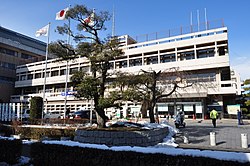Sōka
Sōka
草加市 | |
|---|---|
 Sōka City office | |
|
Pinus | |
| - Flower | Chrysanthemum |
| Phone number | 048-922-0151 |
| Address | 1-1-1 Takasago, Soka-shi, Saitama-ken 840-8550 |
| Website | Official website |

Sōka (草加市, Sōka-shi) is a city in Saitama Prefecture, Japan. As of 1 February 2021[update], the city had an estimated population of 249,645 in 118,129 households and a population density of 9100 persons per km².[1] The total area of the city is 27.46 square kilometres (10.60 sq mi).
Geography
Sōka is situated in the southeast corner of Saitama Prefecture approximately 30 kilometers away from downtown Tokyo. It is surrounded to the east by the cities of Yashio, Misato and Yoshikawa, and to the west by Kawaguchi. To the north is Koshigaya and to the south Adachi Ward of Metropolitan Tokyo.The city is in the center of the
Sōka was once a peaceful agricultural area surrounded by water and greenery, but as a result of urbanization, the once abundant greenery and clean water was adversely affected. Now, Sōka is promoting a "town of greenery and water based on history and the natural features of the area". Creation of areas of greenery reflecting the changes of the four seasons, and the restoration of waterways and environs is being advanced.
Surrounding municipalities
Climate
Sōka has a humid subtropical climate (Köppen Cfa) characterized by warm summers and cool winters with light to no snowfall. The average annual temperature in Sōka is 14.9 °C. The average annual rainfall is 1482 mm with September as the wettest month. The temperatures are highest on average in August, at around 26.5 °C, and lowest in January, at around 3.4 °C.[2]
Demographics
Per Japanese census data,
| Year | Pop. | ±% |
|---|---|---|
| 1960 | 38,533 | — |
| 1970 | 123,269 | +219.9% |
| 1980 | 186,618 | +51.4% |
| 1990 | 206,132 | +10.5% |
| 2000 | 225,018 | +9.2% |
| 2010 | 243,855 | +8.4% |
| 2020 | 248,304 | +1.8% |
History
The area of Sōka has been settled since at least the late
Sōka annexed the neighboring villages of Yatsuka and Shinden on January 1, 1955, followed by the village of Kawayanagi on August 1, 1955. On November 1, 1955, Sōka was elevated to city status. Following this, rapid population expansion and urbanization took hold due to strong economic growth which was fueled by its proximity to Tokyo. The city was proclaimed a tokureishi on April 1, 2004 with increased local autonomy.[4]
Government
Sōka has a
Economy

Sōka traditionally is known for its rice cracker, the Sōka senbei.[5] However, agriculture and food processing form a minor portion of the local economy, which is heavily industrialized. The city is increasingly becoming a commuter town for Tokyo Metropolis.
Education
- Dokkyo University
- Sōka has 21 public elementary schools and 11 public middle schools operated by the city government, and four public high schools operated by the Saitama Prefectural Board of Education. In addition, the prefecture also operates one special education school for the handicapped.
Transportation
Railway
- Yatsuka - Sōka - Dokkyodaigakumae - Shinden
Highway
Twin towns and sister cities
Sōka is
 Carson, California, United States, since November 19, 1985
Carson, California, United States, since November 19, 1985 Shōwa, Fukushima, Japan, friendship city since 1985
Shōwa, Fukushima, Japan, friendship city since 1985 Anyang, Henan, China,[6] since November 1, 1988
Anyang, Henan, China,[6] since November 1, 1988
Local attractions
- Sōka Matsubara
Notable people from Sōka
- Hiroshi Imai, politician
- Yōko Honna, voice actress
- Yumi Morio, actress
- Kenta Kobayashi, wrestler
- Tatsuya Yamaguchi, musician
- Kazuki Hashimoto, wrestler
References
- ^ "Sōka city official statistics" (in Japanese). Japan.
- ^ Sōka climate data
- ^ Sōka population statistics
- ^ a b home page on history of Sōka (in Japanese)
- ^ Sōka home page on history of Sōka senbei (in Japanese)
- ^ "International Exchange". List of Affiliation Partners within Prefectures. Council of Local Authorities for International Relations (CLAIR). Archived from the original on 4 January 2016. Retrieved 21 November 2015.
External links
- Official Website (in Japanese)
